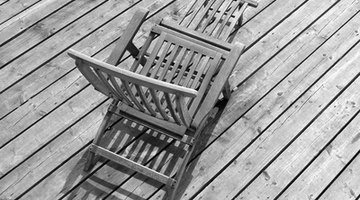How to Calculate Extra Material With Diagonal Decking
Diagonal or herringbone decking can add a visually distinctive pattern to your deck. You may have to budget about double the labor costs, however, compared to a standard installation where boards run at 90 degrees to the joists. While most diagonal decking involves placing the boards at 45 degrees to the joists, you can also install boards at 60 and 30 degrees to the joists, according to Trex.com.

Step 1
Calculate the quantity of decking needed for a regular installation based on your existing plans. For example, a 10-by-10 foot deck requires 100 square feet of coverage. Since typical decking consists of 2-by-6 boards, you’ll need 200 linear feet, or 20 10-foot boards, to cover the planned deck’s surface.
Step 2
Add 15 percent for diagonal installations and add another 10 percent for miscuts or other possible errors. In this example, order 250 feet of boards.
Step 3
Calculate the quantity of extra joists needed. Diagonal installation requires joists spaced 12 inches on center, versus 16 inches for standard builds. For a 10-by-10 foot deck, a regular installation requires seven joists 16 inches apart between the two end joists; a diagonal installation requires nine joists 12 inches apart between the two end joists. Order exactly the amount needed.
Step 4
Double the center joist if the diagonal decking meets in the center of the deck in a herringbone pattern abutting a trim strip. Order an additional joist as well as a 2-by-4 trim strip and a 2-by-6 spacer between the doubled joists, recommends Scott Schuttner in "Building a Deck.”
References
- "Building a Deck;" Scott Schuttner; 2002
- Trex.com: 2009 Trex Installation Guide
- Decks.com: Diagonal Decking
Resources
Writer Bio
An award-winning writer and editor, Rogue Parrish has worked at the Washington Post, the Baltimore Sun and at newspapers from England to Alaska. This world adventurer and travel book author, who graduates summa cum laude in journalism from the University of Maryland, specializes in travel and food -- as well as sports and fitness. She's also a property manager and writes on DIY projects.
Photo Credits
- chair image by Pefkos from Fotolia.com
More Articles



